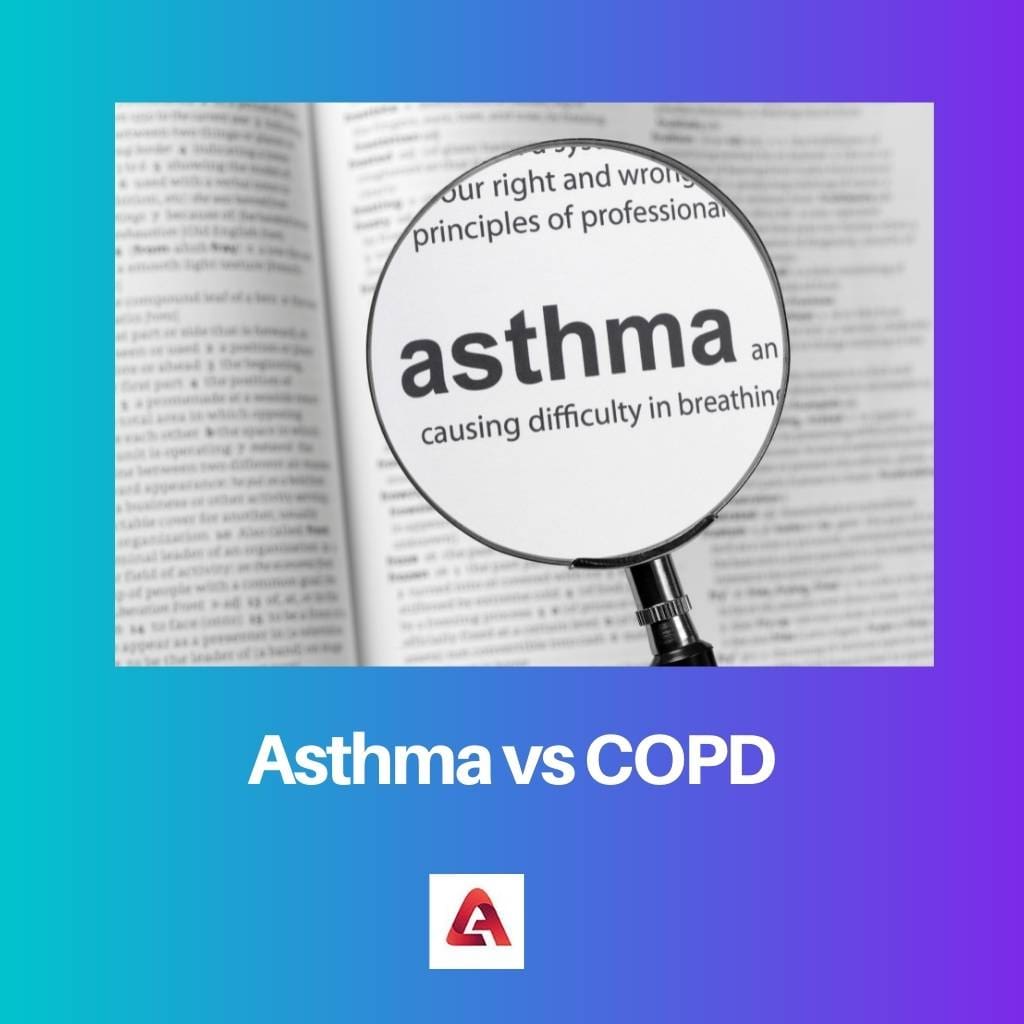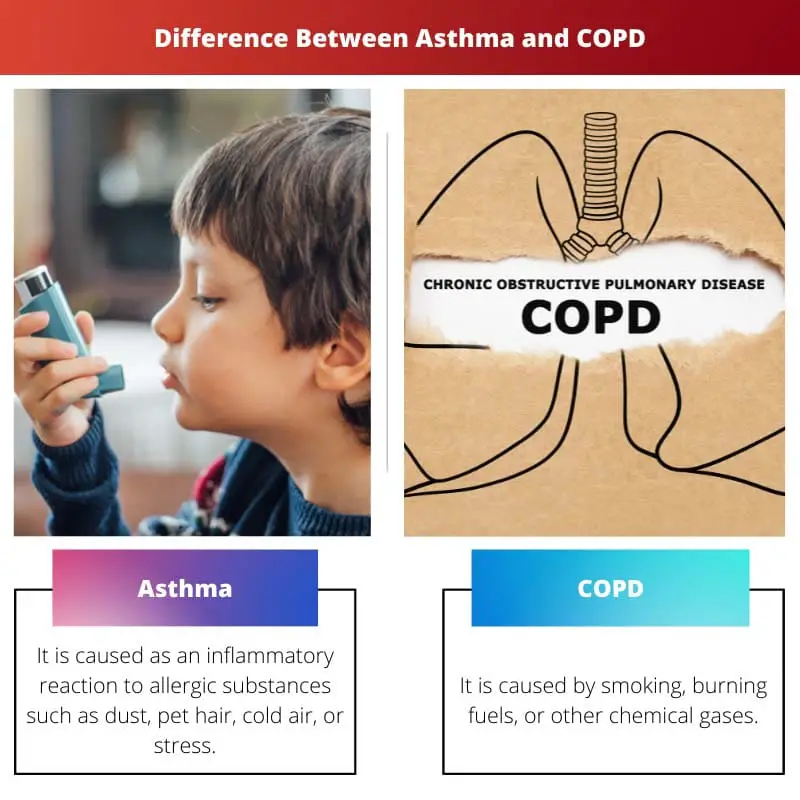Chronic Obstructive pulmonary disease (COPD) and bronchial asthma are Obstructive lung diseases. Both COPD and Asthma affect the bronchial airways called bronchioles in the respiratory tract.
COPD and Asthma both diseases can be diagnosed with the same test called pulmonary function test (PFT). Even though they have a lot of similarities, they are different in many aspects.
Key Takeaways
- Asthma is a reversible inflammatory airway disease characterized by bronchial hyperresponsiveness and episodic symptoms.
- COPD (chronic obstructive pulmonary disease) is a progressive lung disease involving chronic bronchitis and emphysema, leading to irreversible airflow obstruction.
- Both conditions cause breathing difficulties but have different underlying causes and require specific management strategies.
Asthma vs COPD
Asthma is a disease that affects the lungs, developed at a younger age, due to a combination of genetics and environmental triggers. Its symptoms involve a dry cough. COPD is caused by long-term damage to the lungs, from smoking. People who have it are more likely to have a cough with mucus.

Asthma is a hereditary disease caused by genetic and environmental factors. Bronchial inflammation occurs due to an inflammatory reaction caused by allergens such as dust, pollen, cold air, mould, smoke, stress, or physical activity.
Asthma is a chronic respiratory disease that cannot be cured completely but can be managed easily with regular exercises, yoga, and medications.
COPD isn’t a hereditary disease but rarely occurs in people inherited with alpha-1 antitrypsin deficiency (AATD). It is caused due to exposure to various chemical substances such as tobacco smoking, toxic fumes, and gases in the developing world.
COPD can get worse over time, but it can be controlled by regular treatments prescribed by a doctor.
Comparison Table
| Parameters of Comparison | Asthma | COPD |
|---|---|---|
| causes | It is caused as an inflammatory reaction to allergic substances such as dust, pet hair, cold air, or stress. | It is caused by smoking, burning fuels, or other chemical gases. |
| Age | Can be seen at any age. | Can be seen in middle-aged people. |
| symptoms | Wheezing, shortness of breath, and cough. | Wheezing, shortness of breath, and cough. |
| Treatments | Corticosteroids, Bronchodilators, and Bronchial Thermoplasty. | Corticosteroids, Bronchodilators, and surgeries. |
| Response to Treatment | It has a good response to treatment and lung function can be fully reversed. | It also has a good response to treatments, but lung function can get worse over time. |
What is Asthma?
Asthma is a chronic respiratory disease that affects all ages and gender. The oxygen is transported to the lungs through smaller branches of bronchial airways called bronchioles.
During Asthma attacks, these airways get irritated due to the entry of allergic substances into the bronchioles.
The mast cell, a type of immune cell that releases histamine, causes the contraction of surrounding smooth muscles, and the bronchioles get red, swollen, and narrow, making it difficult to breathe.
Asthma is a hereditary disease that can be inherited from blood relatives through generations. A person is more likely to get Asthma through a family history of the disease, but in not all cases, Asthma is inherited because it also has various other risk factors.
The major symptoms of Asthma are wheezing, coughing, and difficulty in breathing. Asthma attacks can be controlled by regular breathing exercises, home remedies such as intake of caffeine, and proper medications prescribed by a doctor.
Asthma has a combination of inhaled and orally taking medicines, it comes in inhalers, syrups, and tablets. The corticosteroids and bronchodilators medications are effective in the long-term run and provide quick relief to Asthma attacks by relaxing the smooth muscles around the bronchioles.

What is COPD?
Chronic Obstructive pulmonary disease (COPD) is a chronic lung disease caused by the airway blocks in the lungs. The bronchioles are inflamed, narrowed, and filled with excess production of mucus, making it hard to breathe.
COPD mainly occurs due to smoking, inhaling toxic chemicals and gases, particulate matter, and fumes from burning fuels, however, smoking is one of the biggest risk factors, and It most affects middle-aged people.
People suffering from COPD have more chance of getting other chronic diseases like lung cancer and heart disease.
COPD is not a hereditary disease however, in rare cases, COPD can be inherited due to a rare genetic disorder called alpha-1 antitrypsin deficiency (AATD), where the level of AAT proteins is very low, and they are unable to protect the lungs.
COPD is a term that represents a set of two chronic lung diseases. Emphysema and chronic bronchitis are caused by inflammation, destruction, and dilation of bronchial tubes in the lungs. Symptoms include wheezing, coughing, shortness of breath, weight loss, and difficulty in breathing.
COPD can be controlled by quitting smoking, exercising regularly, and using proper treatments. Medications such as bronchodilators and corticosteroids are effective in rapidly relaxing muscles around the bronchioles.

Main Differences Between Asthma and COPD
- Both Asthma and COPD are chronic lung diseases, but asthma is a separate respiratory disease, on the other hand, COPD is a term for a group of two chronic lung diseases.
- Asthma is caused due to inhalation of certain allergens, but COPD is caused due to smoking and inhalation of toxic substances.
- Asthmatic inflammation occurs in eosinophils immune cells, but COPD inflammation occurs in neutrophils immune cells.
- Asthmatic symptoms occur only during a certain period, but COPD symptoms can be seen all time.
- In Asthmatic diagnosis, reversible airflow limitations occur, but COPD diagnoses are non-reversible.
- Asthma occurs in all ages, but COPD occurs in middle-age.




